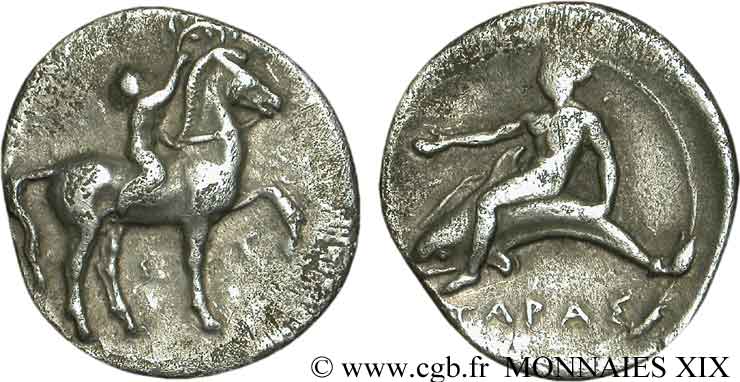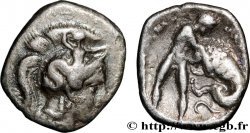v19_0006 - CALABRIA - TARAS Nomos, statère ou didrachme
MONNAIES 19 (2004)
Starting price : 150.00 €
Estimate : 300.00 €
Realised price : 150.00 €
Number of bids : 1
Maximum bid : 155.00 €
Starting price : 150.00 €
Estimate : 300.00 €
Realised price : 150.00 €
Number of bids : 1
Maximum bid : 155.00 €
Type : Nomos, statère ou didrachme
Date: c. 350 AC.
Mint name / Town : Tarente
Metal : silver
Diameter : 22 mm
Orientation dies : 7 h.
Weight : 7,49 g.
Rarity : R2
Coments on the condition:
Pièce sur un flan large et ovale, légèrement décentré au revers avec une usure importante, mais parfaitement visible et identifiable des deux côtés. Une épaisse patine grise recouvre l’ensemble de l’exemplaire à l’empreinte archaïsante
Catalogue references :
Obverse
Obverse description : Cavalier passant au pas à droite, nu, tenant les rênes de son cheval de la main gauche, couronnant son cheval de la main droite.
Obverse legend : S-T
Reverse
Reverse description : Taras nu, chevauchant un dauphin à droite, tendant la main droite, le bras gauche le long du corps.
Reverse legend : TARAS
Commentary
Le style de notre exemplaire est dépouillé. La représentation des deux personnages est hiératique. Sur l’exemplaire de la collection Strozzi, représentée dans l’ouvrage d’O. Ravel et provenant de la collection Vlasto, le revers est décentré comme sur notre nomos et la tête semble se fondre dans le grènetis linéaire.
The style of our example is stripped down. The representation of the two figures is hieratic. On the example from the Strozzi collection, represented in O. Ravel's work and coming from the Vlasto collection, the reverse is off-center as on our nomos and the head seems to blend into the linear graining.
The style of our example is stripped down. The representation of the two figures is hieratic. On the example from the Strozzi collection, represented in O. Ravel's work and coming from the Vlasto collection, the reverse is off-center as on our nomos and the head seems to blend into the linear graining.








 Report a mistake
Report a mistake Print the page
Print the page Share my selection
Share my selection Ask a question
Ask a question Consign / sell
Consign / sell
 Full data
Full data









